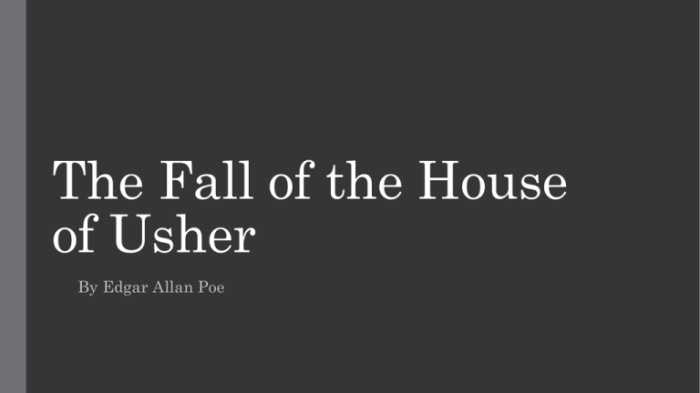Literary devices in the fall of the house of usher – In “The Fall of the House of Usher,” Edgar Allan Poe masterfully employs literary devices to craft a haunting and unforgettable tale of mystery, madness, and decay. These devices not only enhance the story’s atmosphere but also convey deeper meanings, contributing to the work’s enduring impact.
From the evocative imagery to the subtle foreshadowing, Poe’s use of literary techniques creates a vivid and immersive experience for the reader, drawing them into the crumbling world of the Usher family.
Literary Devices in “The Fall of the House of Usher”

Edgar Allan Poe’s “The Fall of the House of Usher” is a classic example of Gothic literature, and its use of literary devices contributes to its haunting and atmospheric tone. These devices include:
Symbolism
- The House of Usher: Represents the decay and decline of the Usher family and the impending doom that awaits them.
- The lake: Symbolizes the boundary between the living and the dead, as well as the inevitable passage of time.
- The crack in the house: Represents the impending doom that awaits the Usher family, as well as the narrator’s own fears and anxieties.
Imagery, Literary devices in the fall of the house of usher
Poe uses vivid and evocative imagery to create a sense of decay and decline. The house is described as “a mansion of gloom,” with “vacant eye-like windows” and “a roof which seemed to lap over the walls in a tent-like manner.”
The narrator describes the interior of the house as “bleak and desolate,” with “dust and cobwebs everywhere.” These images create a sense of unease and foreboding, and contribute to the story’s Gothic atmosphere.
Foreshadowing
Poe uses foreshadowing to create a sense of suspense and dread. The narrator’s initial description of the House of Usher, with its “vacant eye-like windows” and “a roof which seemed to lap over the walls in a tent-like manner,” foreshadows the impending doom that awaits the Usher family.
The narrator’s own fears and anxieties, as well as his increasing sense of isolation, also foreshadow the tragic events that are to come.
Irony
Poe uses irony to create a sense of tragedy. The narrator’s initial description of the House of Usher, with its “vacant eye-like windows” and “a roof which seemed to lap over the walls in a tent-like manner,” foreshadows the impending doom that awaits the Usher family.
However, the narrator is unaware of this impending doom, and his ignorance contributes to the tragedy of the story.
Gothic Elements
Poe uses a number of Gothic elements in “The Fall of the House of Usher” to create a sense of mystery and dread. These elements include the setting of a decaying mansion, the presence of supernatural elements, and the use of dark and foreboding imagery.
These elements contribute to the story’s Gothic atmosphere and help to create a sense of suspense and unease.
Key Questions Answered: Literary Devices In The Fall Of The House Of Usher
What is the significance of the house in “The Fall of the House of Usher”?
The house symbolizes the decay and madness that have consumed the Usher family. Its crumbling facade and gloomy atmosphere mirror the mental and physical decline of Roderick and Madeline Usher.
How does Poe use foreshadowing to build suspense?
Poe subtly hints at the tragic events to come through subtle clues and eerie descriptions. For example, the narrator’s initial encounter with the house and its surroundings foreshadows the impending doom that awaits the Usher family.

